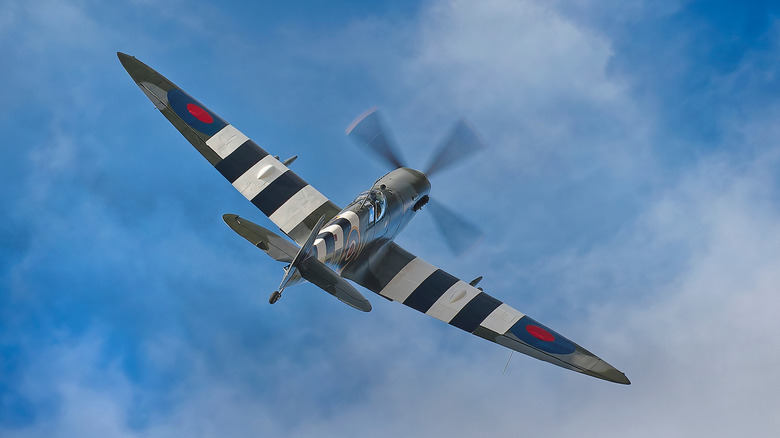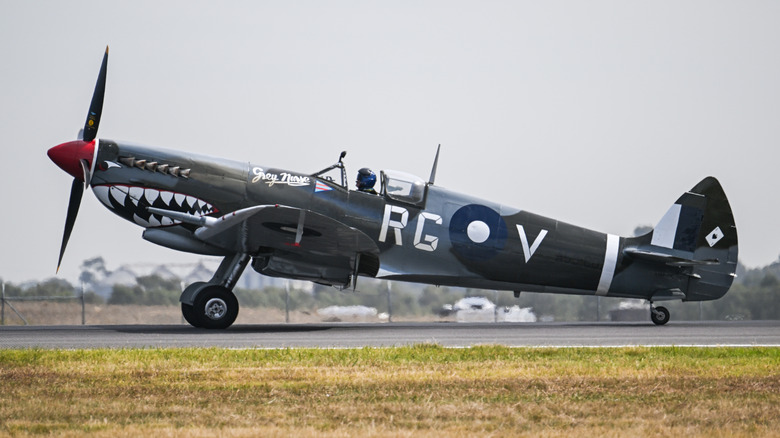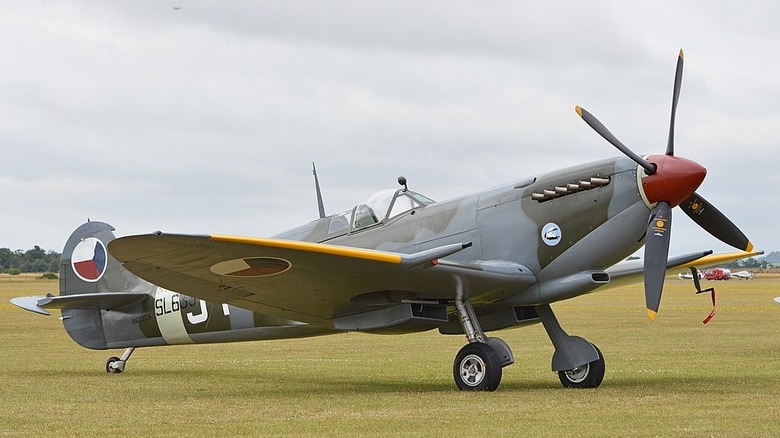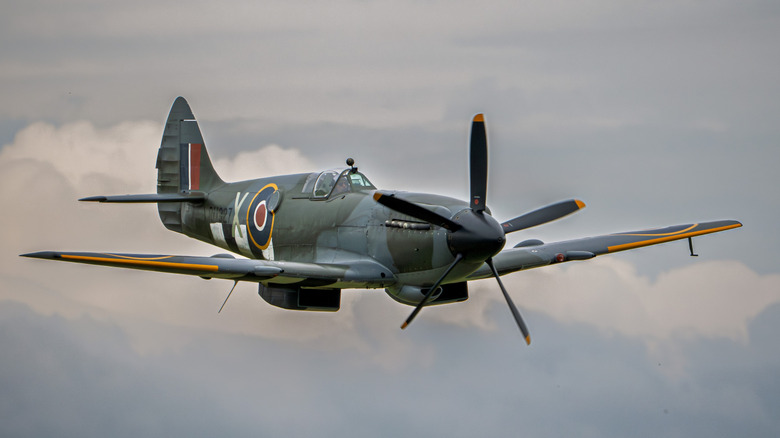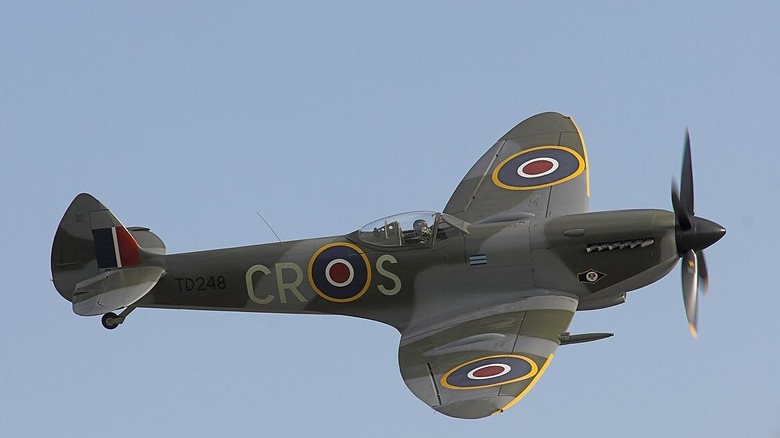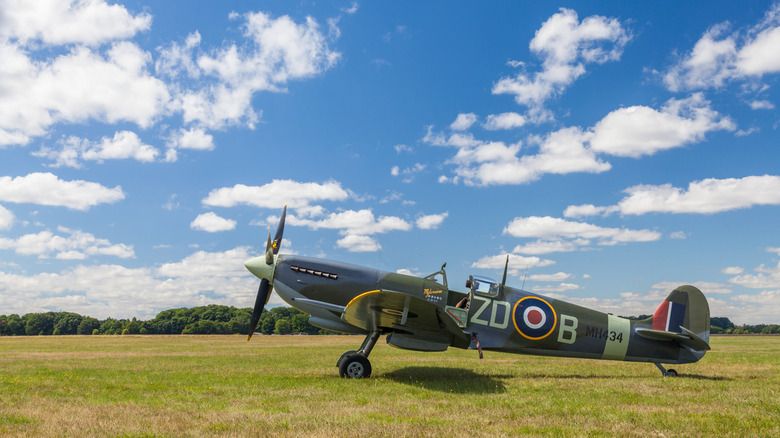5 Of The Fastest Spitfire Versions, Ranked By Top Speed
The Supermarine Spitfire first gained fame for its role defending England alongside other aircraft during the Battle of Britain in the summer of 1940. The Spitfire's pilots soared on distinctive elliptical wings, the distant profile of which signaled safety to England's beleaguered population and danger to the many iconic Axis aircraft.
Formed on a rock-solid basis and beloved by its pilots, the Spitfire first flew in March 1936, and the Mark (Mk) I entered operational service with the Royal Air Force (RAF) in 1938. The modern monoplane design and Merlin engine gave it reliable operation and a top speed of 364 mph.
Over 20,000 Supermarine Spitfires took to the skies through 24 generations. Thanks to Britain's then-intact global empire, the Spitfire even fought in the Pacific Theater and Far East campaigns over Myanmar (then Burma) as part of the British Commonwealth's forces. Yet, like Churchill, its career barely survived the war. The last Spitfire rolled off the line in 1948.
This plane wasn't always the fastest, but it was a respected and formidable participant in history's most ferocious air war. Its distinctive lines and heritage make it a favorite among aviation enthusiasts, and its presence in aviation history belies a surprisingly short career of massive significance. Here are the quickest iterations it ever got.
Mark XII — 397 mph
The Second World War was one of total attrition. Both sides engaged enormous industrial resources to replace and improve war machines. By 1941, the Mark IV Spitfire had already been developed as a prototype for the Mark XII. When it was all said and done, the new Mark XII Spitfire hit the skies over Europe in early 1943 with RAF Squadrons No. 41 and No. 91.
The Mark XII was fast at low to medium altitudes. It could reach speeds of 372 mph at 6,000 feet and 397 mph at 18,000 feet in level flight. A daring pilot might hope to see 450 mph in a dive before the wings tore off. The reason for the jump in power was a dual-stage supercharged Rolls-Royce Griffon II making 1,700 hp.
The 30- to 40-mph increase in top speed and improved climbing rates of the Mark XII kept pace with the wartime arms race. With the Spitfire undergoing constant improvement and upgrading, none of the 24 variants stayed long. Only about 100 Mark XII airframes served as interim mid-war machines while waiting for even more proficient versions.
Mark IX — 400-416 mph
Different Spitfires served in specialized roles, including reconnaissance, escort, air patrol, and ground and naval attack. That's partly why an older Mark IX Spitfire could outperform the Mark XII, achieving a maximum speed of 400-415 mph.
The Mark IX Spitfire began as a conversion of the Mark V design. The Mark Vs had been valiantly clobbered over the skies of France in 1940, with a devastating 500 lost. After the Dunkirk Evacuation, the entire nation of England was spoiling for a fight, including pilots and aeronautical engineers. The Mark IX was intended to be a significant counterpunch for the years to come.
The Spitfire still used the Rolls-Royce Merlin when Mark IX began production in 1943. With updated two-speed dual-stage superchargers, the Merlin in various configurations made between 1,000 and 2,000 hp — one even tested as high as 2,200 horsepower late in 1945. It was with a variation of the Merlin that the Mark IX could reach a maximum speed of 416 mph, although it preferred to cruise at 324 mph. It had a standard range of 434 miles, but combat could quickly reduce that, especially when those enormous superchargers got involved.
The Mark IX was a workhorse variant of the Spitfire. With over 5,500 units built, this fighter plane held the line against some of the best German fighters of the war, including the Messerschmitt Bf 109 and the Focke-Wulf Fw 190, as the Allies mounted offensive operations.
Mark XIV — 440 mph
The Mark XIV arrived prepared to drive the Axis menace back as a significant rethinking of the tried-and-true Spitfire formula. Its 2,000-plus horsepower Rolls-Royce Griffon V12 represented the pinnacle of aircraft aviation power plants of the time. It also carried a pair of .50-caliber machine guns and a pair of 20mm cannons, or four machine guns, in addition to strapping on 250 to 500 pounds of bombs. The plane climbed at 4,580 feet per minute and patrolled a range of 620 miles at an efficiency speed of 271 mph, while attaining a top speed of about 440 mph in level flight.
If the Mark V was the workhorse defender, the Mark XIV was the attack dog. Compared to the over 5,000 Mark Vs built, the U.K. produced under 1,000 Mark XIVs. The new model was significantly faster than the previous, and that was fortunate, because it was required for the daring and desperate duty of delivering some of the final blows against the Third Reich. It was a speedy and up-to-date airframe that could perform multiple duties in an airspace increasingly dominated by Allied forces. By the time the Mark XIV entered the war in January 1944, a desperate Axis was on its back foot and fighting furiously. Pilots of the Mark XIV Spitfire had a front-row seat to the collapsing fascist empires of 1944 and 1945.
Mark 24 — 450 mph
Supermarine switched from Roman to Arabic numerals for later-war Spitfires, and the Marks 21, 22, and 24 also lost some of the early-war grace brought by the elliptical wing shapes and Merlin engines. Coupled with new technology like cabin pressurization, late-war Spitfires were amongst the most modern warplanes flying. But the post-war aviation world looked very different: Mach speeds and jet power were fast approaching.
The Mark 21 Spitfire was the last to see combat during World War II, and it barely made the cut due to flight instability in testing. Ultimately, 3,000 reworked Mark 21s were ordered by the British government, though only 120 were actually produced before the end of the war. The following Mark 23 and Mark 24 represented the final Spits to soar brand-new from the factory when they trickled out in 1946 and 1947.
Each of the final three versions achieved speeds in the 450 mph range – a virtually fatal condition for the Mark I design of just a decade earlier. Some of the Spit's final combat operations occurred in 1948 during the Arab-Israeli War, during which both sides used them. Using a Griffon engine until the end, the Spitfire remained in service until a 1954 reconnaissance mission over Malaysia marked its final operational flight with the Royal Air Force. Although these aircraft could reach significantly higher speeds than the original Spitfires, the piston-powered Mark 24s would be simply inadequate for the emerging age of jet-powered aircraft and Cold War brinksmanship.
Mark XI — 606-621 mph
There is an enormous difference between the maximum safe operating speed of an aircraft and its maximum raw speed. The Mark XI Spitfire receives an honorable mention as the central character in a story about an airframe that survived well beyond its operational limits. The BBC reports two instances of Spitfire pilots pushing Mark XIs well past their proscribed limits and living to tell the tale. During speed trials while testing the Mark XI Spitfire in 1943, test pilot J.R. Tobin engaged in (and survived) a 45-degree dive that reached 606 mph — well beyond safe maximum speeds at level flight.
In April 1944, pilot Anthony Martindale was flying his own Mark XI over Europe when a failed reduction gear caused an oversped dive that reached 620 mph before the propeller sheared off. Martindale lost consciousness as the reduced drag of the separated propeller caused his aircraft to soar violently. When he woke up, he was at 40,000 feet in a powerless Spitfire with wings swept back in a shape that would emerge in future supersonic fighter design. Martindale somehow managed to glide his damaged warplane home.
Both survivors of these wartime incidents were in Mark XI Spitfires, which typically performed high-altitude, high-speed photo reconnaissance runs at up to 400 mph. With such a short but sharp surge of production, not many Spitfires that can still fly are left. Fortunately, organizations, museums, private owners, and historians keep their legacy alive.
